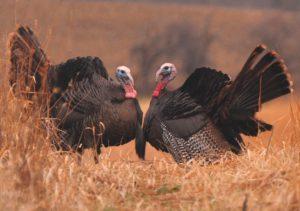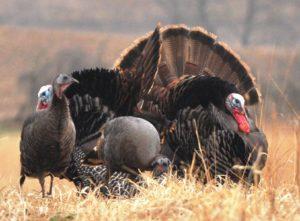Photography courtesy of Lowell Washburn, all rights reserved.
Iowa’s youth turkey hunting season begins April 9. The regular spring seasons commence April 18. For local turkey hunting enthusiasts, the seasons can’t come a minute too soon. Most hunters are already pacing the floor in anticipation of what to expect when they finally take to their favorite woodland in search of the elusive gobbler. Chronic outbreaks of Gobbler Fever are further intensified by this year’s abnormally early snow melt
I’m plenty anxious myself. But regardless of what this year’s hunts may bring, I’ve already had an exciting season. During the past several days I’ve been exploring familiar timbers, blasting away on turkey calls, and generally having an all around good time with preseason gobblers. As always, the boisterous crack-of-dawn turkey shows have been nothing short of spectacular and I’ve had opportunities to watch and photograph adult gobblers as well some jakes and hens. As is usually the case, I’ve had the preseason woodlands all to myself — just me, the birds and an occasional raccoon.
It’s unfortunate that so many spring turkey hunters are entirely missing out on the preseason fun. I blame the pros. For years now, turkey hunting professionals have been using seminars, magazine articles, and other communication mediums to preach the evils of preseason calling. Engaging in such activities will needlessly educate birds, they say, resulting in spooky, call shy toms that will lead to reduced success when hunting seasons finally open for real. Often repeated and widely accepted, the theory has been around since Iowa turkey seasons first began more than thirty years ago.
I’ll admit that the theory does sound logical. In reality, it’s far from the truth. As long as hunters adopt a stealthy common sense approach, preseason excursions with call, binoculars, or camera can result in some of your most productive hours afield.
Upon closer scrutiny, the idea that the gobbler who hears your call, comes looking, and then doesn’t find a real hen will not respond to the same sound another day is just plain ridiculous. Wild turkeys are highly social, highly vocal, and extremely mobile. In the real woods, games of hide and seek play out on a near continual basis. When such scenarios do occur and a roving gobbler doesn’t actually see every hen he hears, that tom will not automatically become a hermit. Think about it.
In reality, hunters have plenty of incentive for getting into the timber well in advance of legal hunting seasons. Generally speaking, spring mornings are crisp and invigorating. As daylight hours continue to lengthen, the predawn gobbling becomes as loud and raucous as it gets. When sunrise approaches and birds finally hit the ground, they rarely fail to provide dramatic displays that include in-your-face gobbling, nonstop strutting, and if you’re extremely fortunate, a good old fashioned Gobbler Smack Down. Those who have enjoyed a ring side seat know that few wildlife dramas are more breath taking than when a couple of long bearded, needle-spurred heavyweights vie for dominance.
In addition to the entertainment value, preseason forays also have a practical side. They offer a chance to explore new territories or to become reacquainted with familiar timbers. They also provide spring turkey enthusiasts with unparalleled opportunities to look, listen and learn as wild turkeys communicate and interact within a completely natural setting. If you really want to know what turkey calling is supposed to sound like, nothing tops the instruction of live hens. It’s an education that can’t be matched – even by the pros. Arming yourself with knowledge obtained directly from the wild bird itself can only serve to increase, not decrease, your probability for future success.
My advice? Quit listening to the pros – at least on this point. Instead, get into the woodlands and enjoy some preseason fun for yourself. Better hurry though. Opening day will be here before you know it.



 Susan Judkins Josten
Susan Judkins Josten Rudi Roeslein
Rudi Roeslein Elyssa McFarland
Elyssa McFarland Mark Langgin
Mark Langgin Adam Janke
Adam Janke Joe Henry
Joe Henry Sue Wilkinson
Sue Wilkinson Tom Cope
Tom Cope Kristin Ashenbrenner
Kristin Ashenbrenner Joe Wilkinson
Joe Wilkinson Dr. Tammy Mildenstein
Dr. Tammy Mildenstein Sean McMahon
Sean McMahon